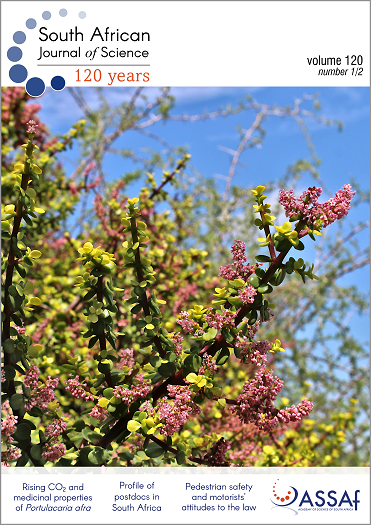Comparative study: Garlic, ginger and turmeric as natural antimicrobials and bioactives
DOI:
https://doi.org/10.17159/sajs.2024/14170Keywords:
natural products, biologically active compounds, antimicrobial, food safety, pathogensAbstract
Biologically active compounds in most spices possess antimicrobial and other important biomedical properties. There have been huge demands for natural immunity boosters (spices and herbs), considering the recent global pandemic and challenges relating to drug-resistant pathogens. This study was designed to compare the efficacy of ginger, garlic and turmeric spices against some pathogenic microorganisms. Aqueous extraction of spices, antimicrobial sensitivity and minimum inhibitory concentration tests were done using standard microbiological methods. Bioactive compounds were estimated using the gas chromatography–mass spectrometry (GC-MS) method. Aqueous extracts of ginger inhibited the growth of all test isolates except Streptococcus pneumoniae, with inhibition zones ranging between 0.9 mm and 13.5 mm. Escherichia coli, S. pneumoniae and Haemophilus influenzae were resistant to turmeric extracts, while the extract of garlic inhibited only four of the test pathogens. Inhibition zones for turmeric ranged between 4.4 mm and 10.9 mm, while those for garlic were between 4.7 mm and 11.5 mm. All the spice extracts did not inhibit microbial growth at 10–40%. An antibiotic spectrum indicated that Bacillus sp. was resistant to all but one, nitrofurantoin, which also inhibited the growth of almost all pathogens, except H. influenzae, with zones ranging between 10.5 mm and 11.6 mm. All test pathogens were resistant to cloxacillin except E. coli (10.6 mm). The major phyto-active compounds present in ginger are 2-Butanone,4-(4-hydroxy-3-methoxyphenyl), 1,3-Cyclohexadiene and 1-(4-Hydroxy-3-methoxyphenyl).
Significance:
Conclusively, ginger, turmeric and garlic have varied inhibitory activities against diverse organisms, indicating their antimicrobial properties; however, ginger showed a higher inhibitory effect and more diverse antimicrobial property amongst selected isolates. Furthermore, certain bioactive compounds of biomedical importance were present. We therefore recommend the use of these spices as alternative natural food preservatives against spoilage organisms, as well as potential natural sources for bioactive compounds in drug development against pathogens.
Published
Issue
Section
License

All articles are published under a Creative Commons Attribution 4.0 International Licence
Copyright is retained by the authors. Readers are welcome to reproduce, share and adapt the content without permission provided the source is attributed.
Disclaimer: The publisher and editors accept no responsibility for statements made by the authors
How to Cite
- Abstract 1328
- PDF 4345
- EPUB 359
- XML 351













.png)